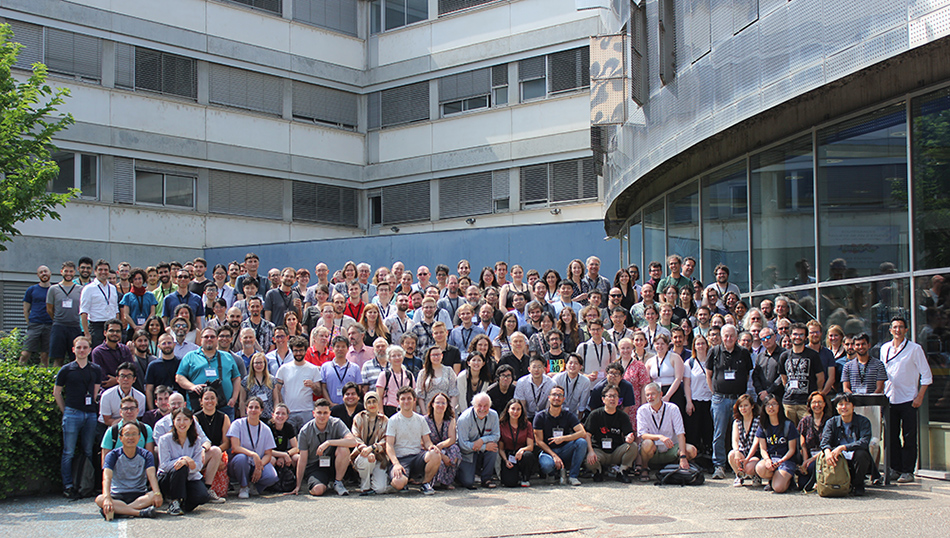Home
Stars are the visible building blocks of the cosmic structures, and as such are essential for our understanding of the Universe and the physical processes that govern its evolution. Star formation lies at the centre of the interstellar matter cycle that drives cosmic evolution. Although star formation is recognised to be central in a wide range of astrophysical processes (galaxy formation and evolution, molecular cloud evolution and destruction, planet formation, and eventually the development of life), it is one of the least understood processes in the Universe.
 Various new instruments have been designed to probe different aspects of the interstellar matter forming stars in the Milky Way, as well as in distant galaxies. The current interferometers, such as ALMA, SMA, and NOEMA, keep increasing the spatial resolution available with the best submillimetre and millimetre observing capabilities. It gives access to small scale structures such as extragalactic molecular clouds, accretion discs, outflows launching sites, and core-scale fragmentation in the Milky Way. The observational data provided by polarimeter on the Planck satellite, the SMA, or ALMA yields indirect information on the structure of the magnetic field in the ISM as well as on the nature of the Galactic dust. Last, star formation is one of the fundamental questions to be addressed by the JWST that will shed light on star forming regions with unprecedented sensitivity in the mid-infrared. In parallel, important international efforts are undertaken to develop large numerical simulations designed for star formation, molecular cloud formation and evolution, as well as the formation of galaxies. These simulations are very challenging because of the complex and multi-scale physics involved, which require the development of new algorithms aimed at massively parallel architectures.
Various new instruments have been designed to probe different aspects of the interstellar matter forming stars in the Milky Way, as well as in distant galaxies. The current interferometers, such as ALMA, SMA, and NOEMA, keep increasing the spatial resolution available with the best submillimetre and millimetre observing capabilities. It gives access to small scale structures such as extragalactic molecular clouds, accretion discs, outflows launching sites, and core-scale fragmentation in the Milky Way. The observational data provided by polarimeter on the Planck satellite, the SMA, or ALMA yields indirect information on the structure of the magnetic field in the ISM as well as on the nature of the Galactic dust. Last, star formation is one of the fundamental questions to be addressed by the JWST that will shed light on star forming regions with unprecedented sensitivity in the mid-infrared. In parallel, important international efforts are undertaken to develop large numerical simulations designed for star formation, molecular cloud formation and evolution, as well as the formation of galaxies. These simulations are very challenging because of the complex and multi-scale physics involved, which require the development of new algorithms aimed at massively parallel architectures.
The aim of this workshop is to bring together the communities related to star formation through the physical scales and cosmic times. This topic is particularly timely for defining major explorations of the star forming Universe to be carried out in the next decade with new instruments designed for observations and exascale HPC. The state-of-the-art of the three pillars of modern astrophysics, theory, observation, and numerical simulations, will be represented. The program will be divided into eight sessions. Each session will be covered by invited reviews, invited presentations as well a large fraction of contributed talks.
Looking forward to see you in Lyon in early summer 2023!

 Various new instruments have been designed to probe different aspects of the interstellar matter forming stars in the Milky Way, as well as in distant galaxies. The current interferometers, such as ALMA, SMA, and NOEMA, keep increasing the spatial resolution available with the best submillimetre and millimetre observing capabilities. It gives access to small scale structures such as extragalactic molecular clouds, accretion discs, outflows launching sites, and core-scale fragmentation in the Milky Way. The observational data provided by polarimeter on the Planck satellite, the SMA, or ALMA yields indirect information on the structure of the magnetic field in the ISM as well as on the nature of the Galactic dust. Last, star formation is one of the fundamental questions to be addressed by the JWST that will shed light on star forming regions with unprecedented sensitivity in the mid-infrared. In parallel, important international efforts are undertaken to develop large numerical simulations designed for star formation, molecular cloud formation and evolution, as well as the formation of galaxies. These simulations are very challenging because of the complex and multi-scale physics involved, which require the development of new algorithms aimed at massively parallel architectures.
Various new instruments have been designed to probe different aspects of the interstellar matter forming stars in the Milky Way, as well as in distant galaxies. The current interferometers, such as ALMA, SMA, and NOEMA, keep increasing the spatial resolution available with the best submillimetre and millimetre observing capabilities. It gives access to small scale structures such as extragalactic molecular clouds, accretion discs, outflows launching sites, and core-scale fragmentation in the Milky Way. The observational data provided by polarimeter on the Planck satellite, the SMA, or ALMA yields indirect information on the structure of the magnetic field in the ISM as well as on the nature of the Galactic dust. Last, star formation is one of the fundamental questions to be addressed by the JWST that will shed light on star forming regions with unprecedented sensitivity in the mid-infrared. In parallel, important international efforts are undertaken to develop large numerical simulations designed for star formation, molecular cloud formation and evolution, as well as the formation of galaxies. These simulations are very challenging because of the complex and multi-scale physics involved, which require the development of new algorithms aimed at massively parallel architectures.The aim of this workshop is to bring together the communities related to star formation through the physical scales and cosmic times. This topic is particularly timely for defining major explorations of the star forming Universe to be carried out in the next decade with new instruments designed for observations and exascale HPC. The state-of-the-art of the three pillars of modern astrophysics, theory, observation, and numerical simulations, will be represented. The program will be divided into eight sessions. Each session will be covered by invited reviews, invited presentations as well a large fraction of contributed talks.
Looking forward to see you in Lyon in early summer 2023!
